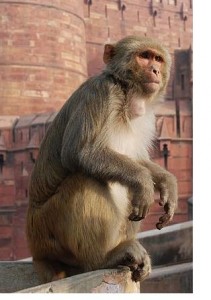THURSDAY, 12 MAY 2011
 Recollection is a key feature of human memory, allowing us to accurately describe and draw images that are not present, for example being able to remember our childhood home. Recall allows memory to extend beyond the immediate environment, so is essential for planning and important in navigation.
Recollection is a key feature of human memory, allowing us to accurately describe and draw images that are not present, for example being able to remember our childhood home. Recall allows memory to extend beyond the immediate environment, so is essential for planning and important in navigation.The identification of recall in species without the ability to speak or draw naturally is challenging, and most studies of memory in monkeys have focused on recognition ability. With a clever experimental design, however, researchers Benjamin Basile and Robert Hampton have been able to test recall ability in five rhesus monkeys, by training them to ‘draw’ simple shapes using a touch screen [1]. In the test, the monkeys were shown part of a previously seen shape in a different location, and their task was to complete the shape by touching the correct areas on the screen. All of the monkeys learned to reproduce the shapes from memory with greater accuracy than expected through chance alone. Furthermore, the monkeys were able to transfer their recall ability to novel shapes on which they had not been extensively trained, indicating a flexible use of recall memory.
The discovery of recall memory in monkeys is a sign that human and monkey memory shares more features than previously imagined. The finding also has implications for evolutionary history, as it suggests that the common ancestor of humans and Old World monkeys may have shared the ability to recall [2].
Written by Talya Underwood
